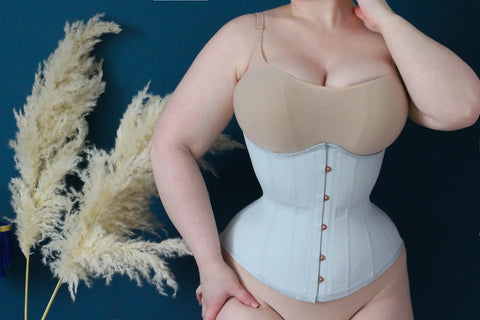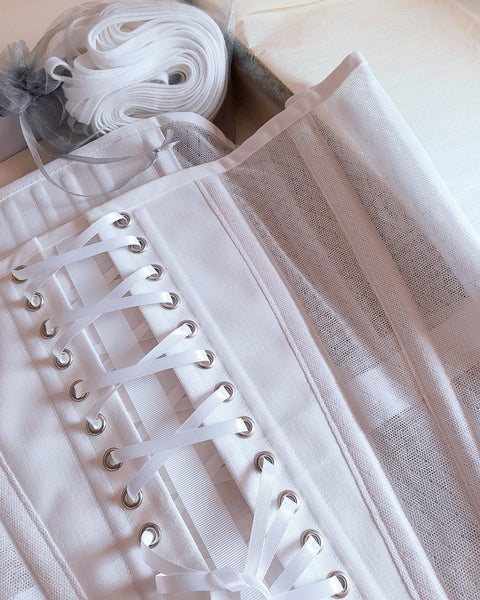At Orchid, I have the honour of introducing many newcomers to waist training. This is the discipline of gradual waist reduction, through regular wear of a tightlacing corset. Perhaps you have started this journey with intentions to taper the ribcage to a wasp waisted silhouette. Or maybe to encourage better posture, and to enjoy the secure, snug sensation of being tightly cinched. There are so many different, exciting reasons to find yourself drawn to waist training! In the Mid Wales studio I have worked on training corsets for all body types over the years, so my clients are in safe hands for this wonderful process. Today, I’d like to share with you about some important care techniques for your new corset, as well as some tips for a safe and healthy approach to waist training, whatever your lifestyle.

Seasoning Your Corset
A corset is a unique garment that sculpts and enhances the figure, through cut, fit and construction of exacting finesse. It’s a thrilling moment when your first corset arrives at your door, swathed in tissue paper. It’s waiting to be tried on, and drawn in to reveal a curve and sweep to your waist that you didn’t know was there…
But before you give into that understandable excitement, let's make sure that your next step protects the life of your new treasure and investment. Not to mention your long-term wellbeing! You may have heard about seasoning or breaking in your corset (a practise of gently wearing the corset in until it is closed at its intended reduction) and now is the time to put it into practice.
It’s important that for the first few weeks of owning your corset you begin by lacing it quite loosely at the back. Don’t try to experience the full extent of the reduction until you have accustomed yourself to wearing the piece, feeling the pressure of 2 inches of cinch and no more. Two hours or so is plenty to wear this in each day, and after a fortnight of this careful lacing process you can gradually start to bring your corset in to its intended snug fit. The first few wears should not be a battle to close the gap. It’ll all happen in time, and taking this precaution will prevent stress on the fibres of your corset, and the stitching that maintains it’s contours. Corset wearing is about many things, but impatience is not one of them!

Why Is It Important?
Why is it necessary to take these careful precautions with a traditionally constructed corset, made with the very best quality materials? Well, one reason is that it allows you to gently get used to the pressure of a new corset, particularly if it's your first one, or if you don't wear one regularly. But also, you are giving the corset time to slowly mould to your body, both the fibres of the material, and the stitching are finding tensions and settling into place. Forcing the corset to close too early can result in weakening the overall structure and, occasionally and sadly, breakages.
To hear the words of a regular corset wearer on the matter I recommend you watch this video by Lucy’s corsetry, which covers her own experience with undue care at the early stages of corset wear.
I think this paced and steady introduction is also an ideal approach for beginning your journey with waist training. It prepares the wearer for slow and regular progress whilst avoiding the pitfall that so many would-be tightlacers experience. Going too fast, too soon can result in you being given a negative impression of the whole affair, and finding reasons not to persist with their efforts. And I want you to love this new corset for a long time!

Waist Training
Once you’ve reached the status of a regular tightlacer, I think it’s easy to become fixated on continual, inflexible lacing habits. The fact that it is described as “a discipline” means that some people get the impression that we must lace as tightly as we can, for as long as we can bear. Whilst some people may embrace the challenge that this offers, it doesn’t really fit in with most modern lifestyles. We do not always have the ability to control our diets to optimum effect, we may feel unwell one day or need to be more active, with much bending from the waist and rushing around in the summer heat. All these things affect how you feel in the corset laced to your preferred degree, or even if you want to wear it at all. It’s important that you don’t feel that you have let down your hard endeavours by needing to loosen your lacing after lunch, or that it “doesn’t count” if you didn’t reach the number of hours you intended to one day. It’s true that you must persevere to reach your goals, but your body is an organic machine and does not always behave predictably!

Intuitive Tightlacing
Fran Blanche from Contour Corsets promotes what I feel is a very healthy and sensible approach to tightlacing. You can read about her Cycle Method which talks about understanding that you will likely need more flexibility in your approach to waist training than simply tightening it in the morning and releasing it before bed. Reading this helped me to understand that I wasn’t bad at tightlacing- I just couldn’t expect the corset to accommodate me, my meal and the strains of the day without feeling additional pressure. Once I realised this, I found that my occasional grudging feelings towards the corset going on in the morning were not a problem. I understood that a day of less consistent wear did not mean going back to step one, and I was able to simply take it at my pace, at the level that running a bustling business allows.
Other Important Points For Waist Trainers
The most important first step when considering starting waist training is to consult your GP. Your doctor may have advice for you about managing other underlying health conditions such as high blood pressure with your intended schedule. It is vital that you take these assurances before beginning to plan your corsets with your corsetiere.

Food and diet
Your diet makes a big difference to how you experience wearing your training corset. Our typical western way of consuming food is not very conducive to 23/7 or extended corset wear. We tend to have a “feast and famine” approach, taking a large meal, then after hours of nothing, eating another hearty meal. Consider that this food takes 6-8 hours to be digested properly, and you can see why you may experience discomfort and additional pressure within the corset that could easily be dispensed with by eating small amounts, more regularly.
The types of food and drink that you consume will also contribute to your comfort and ease of wear. Fizzy drinks and carbohydrates that expand in the stomach, or sit there heavily such as pasta should be taken in smaller quantities, self-regulation will help you to find the best limits for your body. There is absolutely no need to reduce your healthy daily calorie intake just to alter your quantities and balance your meals.
Core strength
Something that many tightlacers who are just starting out can forget is to keep their core muscle strength up. This is absolutely vital for those working on a 23/7 routine, and making time in your day for a few simple exercises will take care of strength in your abdomen and back. Pilates or yoga targets these areas well, as do many traditional warm-up exercises that can be done in your own home without gym subscriptions or pricey equipment.

Skin health
Protecting the skin is another essential part of training. If you tightlace daily for long hours your skin is given very little chance to breathe, and trapped moisture can cause problems. Always endeavour to have a corset liner made of natural fibres underneath, as although your corset can’t be washed, a liner or camisole can. You should change your liner every single day. This forms a barrier against perspiration from the lining of your corset and protects the tender skin of the waist from any chafing.
We stock the very lightest and breathable silk corset liners for just this purpose, just drop us a line to learn more about how they can contribute to your training regimen. Keeping up a moisturising routine is also important, but make sure that the creams have fully absorbed before beginning to dress.
Nighttime waist training
Another way to protect your skin from prolonged contact with perspiration is to change your corset for bed, should you be continuing to train at night-time. Many of our clients find that their lacing at night uses less reduction than their typical daytime corset would provide. This is known as maintenance training. So a ribbon corset, which is lighter and with more ventilation than our regular construction methods, makes a great alternative.
Ribbon corsets fit into the “waspie” part of the spectrum, meaning that they typically cover 3″ above and below the waist at the sides, with longer front and back edges. Ribbon corsets are also unique in that their main construction is created from diagonal and horizontal strips of ribbon, using fewer steel bones to create their shaping. The added flexibility at the sides from the shorter length means that movement during sleep is less inhibited, and should therefore prove more comfortable.

Airing and cleaning your corset
The same corset should never be worn two days running if it can be helped, as you may have read in our care of your corset section. We recommend that you air out your corset overnight to ensure that it’s fresh for your next wear, and alternating your corsets regularly will not only prevent excessive wear on one piece but will make certain that before you put it back on, all perspiration has dried. You can also gently wipe the lining of your corset with a well wrung out cloth after wear to help the process and save on trips to the dry cleaners!
I hope that these tips help you to enjoy your corset for even longer, and to progress with your training safely and with joy. Waist training is not a practise to be treated with trepidation, but it is something to treat with attention, care and respect. You need to listen to your body’s warnings if you are moving quickly down through the waist sizes. Cramps, discomfort and other pain should not be ignored. It may be that your chosen corset style needs further fine tuning, or that it’s time to take a step back for a while. If you’re having persistent problems don’t hesitate to contact your corsetiere for support. We don’t have all the answers but we might just have a new insight for you!


